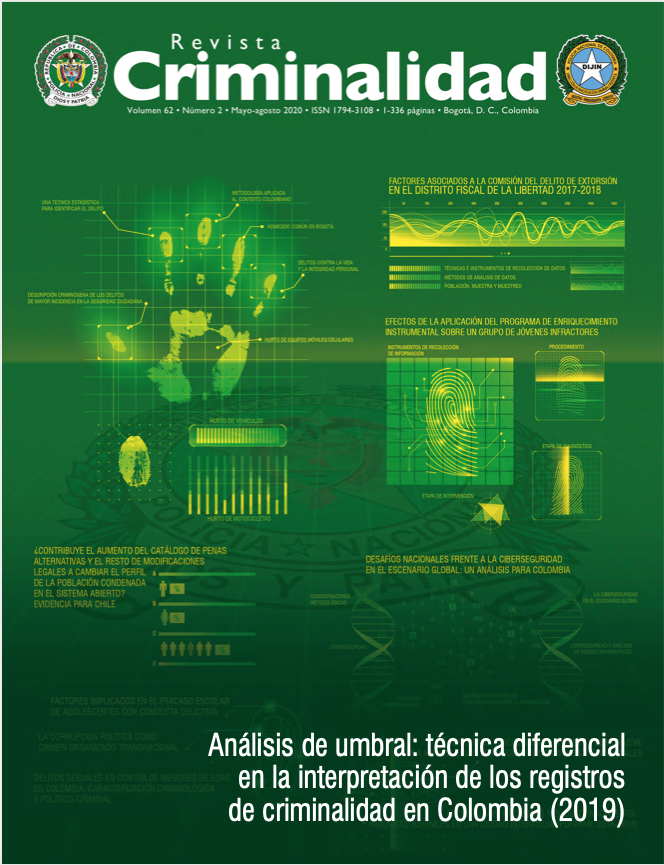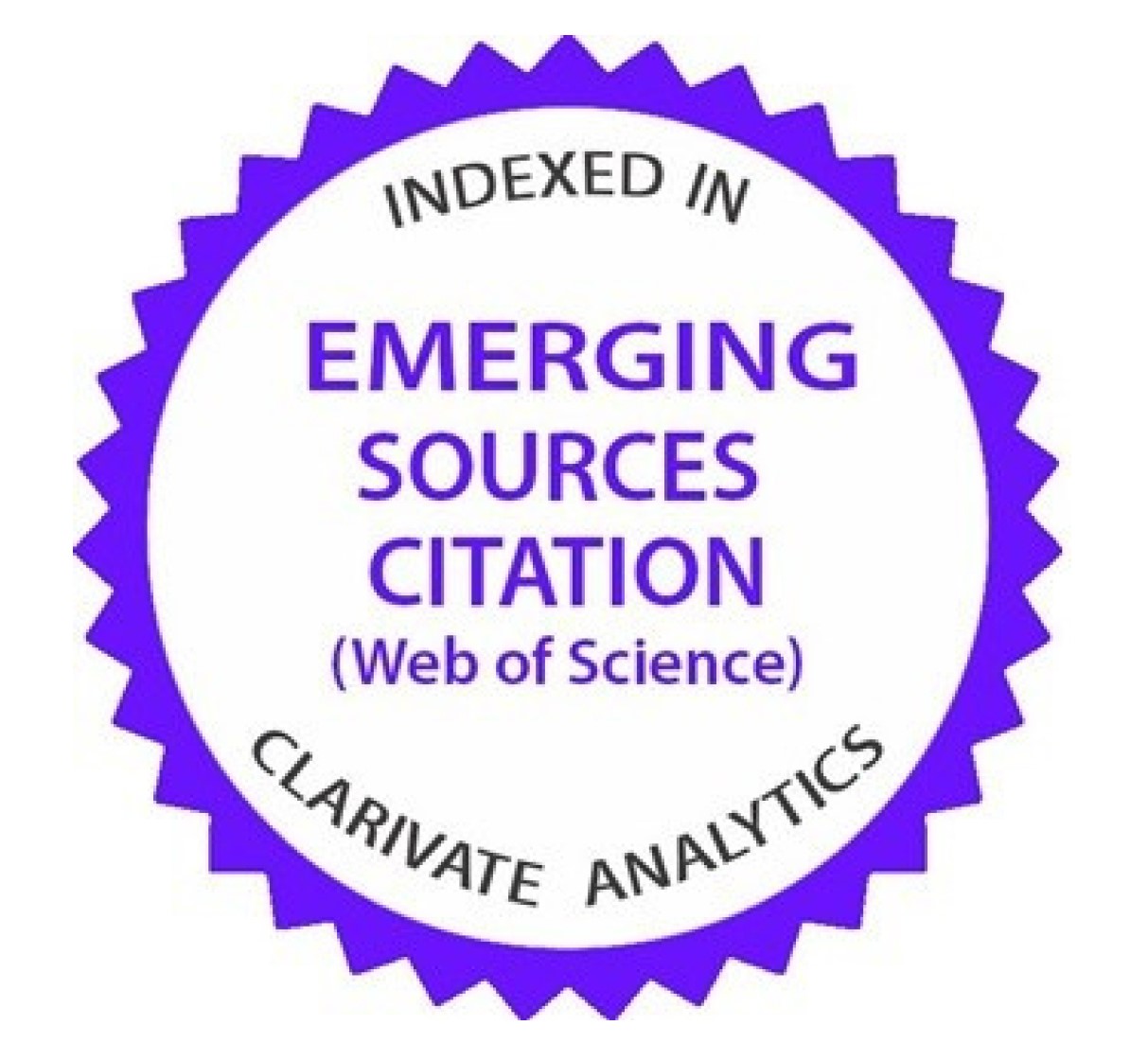Sexual Offense, between Reason and the Heart: a Look from Cognitive and Emotional Processes
DOI:
https://doi.org/10.47741/17943108.172Keywords:
sex crime, emotion, criminal etiology, sexual offender, cognitionAbstract
Researching the etiology of sexual offenses from a cognitive and emotional dimension demonstrates a prominent increase in the last three decades. However, this reflection article’s specific objective is to reveal the clear excesses, violations, absences and needs in developing and treating the convergent constructs in both dimensions. To do so, the way cognitive processes influence sexual offenses will be explained first. Then, we will state how said actions can be explained based on theories of emotions. Finally, we will attempt to establish an interpretative proposal for the problem that includes the cognitive and emotional dimensions, as well as fundamental aspects to understand sexual offenses. Therefore, it was concluded that developing new and improved theories that articulate emotions and cognitions is necessary to properly explain offender’s movements in committing sex crimes.
Downloads
References
Abel, G. G., Becker, J. V. y Cunningham-Rathner, J. (1984). Complications, Consent, and Cognitions in Sex Between Children and Adults. International Journal of Law and Psychiatry, 7(1), 89-103. https://doi.org/10.1016/0160-2527(84)90008-6
Ainsworth, M. D. S., Blehar, M. C., Waters, E. y Wall, S. (1978). Patterns of attachment: A psychological study of the strange situation. Oxford: Lawrence Erlbaum. https://doi.org/10.1037/t28248-000
Arndt, W. B., Foehl, J. C. y Good, F. E. (1985). Specific Sexual Fantasy Themes: A Multidimensional Study. Journal of Personality and Social Psychology, 48(2), 472-480. https://doi.org/10.1037/0022-3514.48.2.472
Bachman, R., Paternoster, R. y Ward, S. (1992). The Rationality of Sexual Offending: Testing a Deterrence/Rational Choice Conception of Sexual Assault. Law and Society Review, 26(2), 343-372. https://doi.org/10.2307/3053901
Baron Cohen, S., Wheelwright, S., Hill, J., Raste, Y. y Plumb, I. (2001). The “Reading the Mind in the Eyes” Test Revised Version: A Study with Normal Adults, and Adults with Asperger Syndrome or High Functioning Autism. Journal of Child Psychology and Psychiatry, 42(2), 241- 251. https://doi.org/10.1111/1469-7610.00715
Beck, A. T. (Ed.). (1979). Cognitive Therapy of Depression. New York: Guilford Press.
Beech, A. R. y Mitchell, I. J. (2005). A Neurobiological Perspective on Attachment Problems in Sexual Offenders and the Role of Selective Serotonin Re-Uptake Inhibitors in the Treatment of such Problems. Clinical Psychology Review, 25(2), 153- 182. https://doi.org/10.1016/j.cpr.2004.10.002
Beech, A. R., Bartels, R. M. y Dixon, L. (2013). Assessment and Treatment of Distorted Schemas in Sexual Offenders. Trauma, Violence & Abuse, 14(1), 54-66. https://doi.org/10.1177/1524838012463970
Blake, E. y Gannon, T. (2008). Social Perception Deficits, Cognitive Distortions, and Empathy Deficits in Sex Offenders: A Brief Review. Trauma, Violence, & Abuse, 9(1), 34-55. https://doi.org/10.1177/1524838007311104
Blumenthal, S., Gudjonsson, G. y Burns, J. (1999). Cognitive Distortions and Blame Attribution in Sex Offenders Against Adults and Children. Child Abuse & Neglect, 23(2), 129-143. https://doi.org/10.1016/S0145-2134(98)00117-3
Carabellese, F., Maniglio, R., Greco, O. y Catanesi, R. (2011). The Role of Fantasy in a Serial Sexual Offender: A Brief Review of the Literature and a Case Report. Journal of Forensic Sciences, 56(1), 256-260. https://doi.org/10.1111/j.1556-4029.2010.01536.x
Castellino, N., Bosco, F. M., Marshall, W. L., Marshall, L. E. y Veglia, F. (2011). Mindreading Abilities in Sexual Offenders: An Analysis of Theory of Mind Processes. Consciousness and Cognition, 20(4), 1612-1624. https://doi.org/10.1016/j.concog.2011.08.011
Cochran, W. y Tesser, A. (1996). The “what the hell” effect: Some effects of goal proximity and goal framing on performance. In L. L. Martin y A. Tesser (Eds.), Striving and feeling: Interactions among goals, affect, and self-regulation (pp. 99- 120). Hillsdale, NJ, US: Lawrence Erlbaum Associates, Inc.
Cohen, L. J., Nikiforov, K., Gans, S., Poznansky, O., McGeoch, P., Weaver, C. y Galynker, I. (2002). Heterosexual Male Perpetrators of Childhood Sexual Abuse: a Preliminary Neuropsychiatric Model. Psychiatric Quarterly, 73(4), 313-336. https://doi.org/10.1023/A:1020416101092
Cornish, D. B. y Clarke, R. V. (1987). Understanding Crime Displacement: An Application of Rational Choice Theory. Criminology, 25(4), 933-948. https://doi.org/10.1111/j.1745-9125.1987.tb00826.x
Craissati, J. (2015). Should We Worry About Sex Offenders Who Deny Their Offences? Probation Journal, 62(4), 395-405. https://doi.org/10.1177/0264550515600543
Damasio, A. R. (2010). Y el cerebro creó al hombre. Barcelona: Destino.
Davids, O., Londt, M. y Wilson, L. (2015). Imprisoned Sex Offenders’ Chronic Denial and Their Childhood Family Environment. The Open Family Studies Journal, 7(1). https://doi.org/10.2174/1874922401507010042
Davis, M. H. (1983). Measuring Individual Differences In Empathy: Evidence For A Multidimensional Approach. Journal of Personality and Social Psychology, 44(1), 113-126. https://doi.org/10.1037/0022-3514.44.1.113
Day, A., Mohr, P., Howells, K., Gerace, A. y Lim, L. (2012). The Role of Empathy in Anger Arousal in Violent Offenders and University Students. International Journal of Offender Therapy and Comparative Criminology, 56(4), 599-613. https://doi.org/10.1177/0306624X11431061
DeLisi, M. y Piquero, A. R. (2011). New Frontiers in Criminal Careers Research, 2000–2011: A State-Of-The-Art Review. Journal of Criminal Justice, 39(4), 289-301. https://doi.org/10.1016/j.jcrimjus.2011.05.001
De Sousa, R. B. (1988). “Emotion and Self-Deception”. In B. P. McLaughlin and A. O. Rorty. (Eds.). Perspectives on Self-Deception (pp. 325-341). Berkeley, CA: University of California Press.
Deu, N., y Edelmann, R. J. (1997). The Role of Criminal Fantasy in Predatory and Opportunist Sex Offending. Journal of Interpersonal Violence, 12(1), 18-29. https://doi.org/10.1177/088626097012001002
Dolan, M., Millington, J. y Park, I. (2002). Personality and Neuropsychological Function in Violent, Sexual and Arson Offenders. Medicine, Science and the Law, 42(1), 34-43. https://doi.org/10.1177/002580240204200107
Drieschner, K. y Lange, A. (1999). A Review of Cognitive Factors in the Etiology of Rape: Theories, Empirical Studies, and Implications. Clinical Psychology Review, 19(1), 57-77. https:// doi.org/10.1016/S0272-7358(98)00016-6
Ellis, A. (1979). Rational-Emotive Therapy: Research Data that Support the Clinical and Personality Hypotheses of RET and other Modes OF Cognitive-Behavior Therapy. In A. Ellis & J.M. Whiteley (Eds.). Theoretical and Empirical Foundations of Rational-Emotive Therapy (pp. 101-173). Monterey, CA: Brooks/Cole.
Ellis, A. y Abrahms, E. (1994). Terapia racional-emotiva (TRE): Mejor salud y superación personal afrontando nuestra realidad. México: Pax Mexico.
Elsegood, K. J. y Duff, S. C. (2010). Theory of Mind in Men Who Have Sexually Offended Against Children: A UK Comparison Study Between Child Sex Offenders and Nonoffender Controls. Sexual Abuse, 22(1), 112-131. https://doi.org/10.1177/1079063209359926
Finkelhor, D. (1984). The Prevention of Child Sexual Abuse: An Overview of Needs and Problems. Siecus Report, 13(1), 1-5.
Frank, R. H. (1988). Passions within Reason: The Strategic Role of The Emotions. New York: WW Norton & Co.
Gallagher, S. y Schmicking, D. (2010). Handbook of Phenomenology and Cognitive Science. New York: Springer. https://doi.org/10.1007/978-90-481-2646-0
Gannon, T. A. y Polaschek, D. L. (2006). Cognitive Distortions in Child Molesters: A ReExamination of Key Theories and Research. Clinical Psychology Review, 26(8), 1000-1019. https://doi.org/10.1016/j.cpr.2005.11.010
Gladstein, G. A. (1983). Understanding Empathy: Integrating Counseling, Developmental, and Social Psychology Perspectives. Journal of Counseling Psychology, 30(4), 467-482. https://doi.org/10.1037/0022-0167.30.4.467
Gray, N. S., Watt, A., Hassan, S. y Macculloch, M. J. (2003). Behavioral Indicators of Sadistic Sexual Murder Predict the Presence of Sadistic Sexual Fantasy in a Normative Sample. Journal of Interpersonal Violence, 18(9), 1018-1034. https://doi.org/10.1177/0886260503254462
Grossman, L., Martis, B. y Fichtner, C. (1999). Are Sex Offenders Treatable? A Research Overview. Psychiatric Services, 50(3), 349-361. https://doi.org/10.1176/ps.50.3.349
Hall, G. C. N. y Hirschman, R. (1992). Sexual Aggression Against Children: A Conceptual Perspective of Etiology. Criminal Justice and Behavior, 19(1), 8-23. https://doi.org/10.1177/0093854892019001003
Hart, S. D. y Hare, R. D. (1997). Psychopathy: Assessment and Association with Criminal Conduct. In D. M. Stoff, J. Breiling y J. D. Maser (Eds.). Handbook of Antisocial Behavior (pp. 22- 35). Hoboken, NJ, US: John Wiley & Sons Inc.
Hazama, K. y Katsuta, S. (2016). Cognitive Distortions among Sexual Offenders Against Women in Japan. Journal of Interpersonal Violence, 34(16), 3372–3391. https://doi.org/10.1177/0886260516669544
Hempel, I. S., Buck, N. M. L., Van Vugt, E. S. y Van Marle, H. J. C. (2015). Interpreting Child Sexual Abuse: Empathy and Offense-Supportive Cognitions Among Child Sex Offenders. Journal of Child Sexual Abuse, 24(4), 354-368. https://doi.org/10.1080/10538712.2015.1014614
Hucker, S., Langevin, R., Wortzman, G., Bain, J., Handy, L., Chambers, J. y Wright, S. (1986). Neuropsychological Impairment in Pedophiles. Canadian Journal of Behavioural Science/Revue Canadiennedes Sciences du Comportement, 18(4), 440. https://doi.org/10.1037/h0079965
Hudson, K. (2013). Offending Identities. London: Routledge. https://doi.org/10.4324/9781843926443
Hurley, S. L. (1998). Consciousness in action. Boston, MA: Harvard University Press.
Kaplan, H. y Sadock, B. (1990). Compendio de psiquiatría. Madrid: Editorial La Nave.
Kerem, E., Fishman, N. y Josselson, R. (2001). The Experience of Empathy in Everyday Relationships: Cognitive and Affective Elements. Journal of Social and Personal Relationships, 18(5), 709-729. https://doi.org/10.1177/0265407501185008
Leitenberg, H. y Henning, K. (1995). Sexual Fantasy. Psychological Bulletin, 117(3), 469-496. https:// doi.org/10.1037/0033-2909.117.3.469
Loinaz, I., Echeburúa, E. y Ullate, M. (2012). Estilo de apego, empatía y autoestima en agresores de pareja. Terapia psicológica, 30(2), 61-70. https://doi.org/10.4067/S0718-48082012000200006
MacCulloch, M. J., Snowden, P. R., Wood, P. J. W. y Mills, H. E. (1983). Sadistic Fantasy, Sadistic Behaviour and Offending. The British Journal of Psychiatry, 143(1), 20-29. https://doi.org/10.1192/bjp.143.1.20
Maniglio, R. (2010). Child Sexual Abuse in the Etiology of Depression: A Systematic Review of Reviews. Depression and Anxiety, 27(7), 631-642. https://doi.org/10.1002/da.20687
Marshall W. L. y Barbaree H. E. (1990). “An Integrated Theory of the Etiology of Sexual Offending”. In: Marshall W. L., Laws D. R., Barbaree H. E. (Eds). Handbook of Sexual Assault. Applied Clinical Psychology. Boston: Springer. https://doi.org/10.1007/978-1-4899-0915-2
Marshall, W. L. y Hambley, L. S. (1996). Intimacy and Loneliness, and their Relationship to Rape Myth Acceptance and Hostility Toward Women Among Rapists. Journal of Interpersonal Violence, 11(4), 586-592. https://doi.org/10.1177/088626096011004009
Marshall, W. L., Hamilton, K. y Fernández, Y. (2001). Empathy Deficits and Cognitive Distortions in Child Molesters. Sexual Abuse, 13(2), 123-130. https://doi.org/10.1177/107906320101300205
Marshall, W. L., Hudson, S. M., Jones, R. y Fernández, Y. M. (1995). Empathy in Sex Offenders. Clinical Psychology Review, 15(2), 99-113. https://doi.org/10.1016/0272-7358(95)00002-7
Marshall, W. L., Laws, D. R. y Barbaree, H. E. (1990). Issues in Sexual Assault. In: Handbook of Sexual Assault. Applied Clinical Psychology. Boston: Springer. https://doi.org/10.1007/978-1-4899-0915-2
Marshall, W., Marshall, L., Serran, G. y O‘Brien, M. D. (2013). “What Works in Reducing Sexual Offending”. In: L. Craig, L. Dixon, T. Gannon. (Eds.) What Works in Offender Rehabilitation: An EvidenceBased Approach to Assessment and Treatment (pp. 173-191). NY: John Wiley & Sons. https://doi.org/10.1002/9781118320655.ch10
McPhail, I. V., Hermann, C. A. y Fernández, Y. M. (2014). Correlates of Emotional Congruence with Children in Sexual Offenders Against Children: A Test Of Theoretical Models in an Incarcerated Sample. Child Abuse and Neglect, 38(2), 336-346. https://doi.org/10.1016/j.chiabu.2013.10.002
Murphy, W. D. (1990). Assessment and Modification of Cognitive Distortions in Sex Offenders. In Handbook of Sexual Assault (pp. 331-342). Boston: Springer. https://doi.org/10.1007/978-1-4899-0915-2_19
Nelson, E. E. y Panksepp, J. (1998). Brain Substrates of Infant– Mother Attachment: Contributions of Opioids, Oxytocin and Norepinephrine. Neuroscience & Biobehavioral Reviews, 22(3), 437-452. https://doi.org/10.1016/S0149-7634(97)00052-3
Ó Ciardha, C. y Ward, T. (2013). Theories of Cognitive Distortions in Sexual Offending: What the Current Research Tells Us. Trauma, Violence & Abuse, 14(1), 5-21. https://doi.org/10.1177/1524838012467856
Ó Ciardha, C. y Gannon, T. A. (2011). The Cognitive Distortions of Child Molesters are in Need of Treatment. Journal of Sexual Aggression, 17(2), 130-141. https://doi.org/10.1080/1355 2600.2011.580573
Ortega, J. E., Callado, L. F. y Meana, J. J. (2008). El sistema noradrenérgico en la neurobiología de la depresión. Psiquiatría Biológica, 15(5), 162-174. https://doi.org/10.1016/S1134-5934(08)76487-X
Pereda, N., Guilera, G., Forns, M. y Gómez-Benito, J. (2009). The Prevalence of Childsexual Abuse in Community and Student Samples: A MetaAnalysis. Clinical Psychology Review, 29(4), 328- 338. https://doi.org/10.1016/j.cpr.2009.02.007
Polaschek, D. L. (2003). Relapse Prevention, Offense Process Models, and the Treatment of Sexual Offenders. Professional Psychology: Research and Practice, 34(4), 361-367. https://doi.org/10.1037/0735-7028.34.4.361
Pollock, N. L. y Hashmall, J. M. (1991). The Excuses of Child Molesters. Behavioral Sciences & the Law, 9(1), 53-59. https://doi.org/10.1002/bsl.2370090107
Pons-Salvador, G., Martínez, A., Pérez, M. y Borrás, J. J. (2006). La evaluación del abuso sexual infantil: comparación entre informes periciales en función del diagnóstico de abuso. Psychosocial Intervention, 15(3), 317-330. https://doi.org/10.4321/S1132-05592006000300006
Prentky, R. A., et al. (1989). The Presumptive Role of Fantasy in Serial Sexual Homicide. American Journal of Psychiatry, 146(7), 887-891. https://doi.org/10.1176/ajp.146.7.887
Redondo F., C., y Otero, O. (2005). Abuso sexual infantil. Boletín de pediatría, 45(191), 3-16. http://sccalp.org/boletin/191/BolPediatr2005_45_003-016.pdf.
Romero Martínez, Á., Lila, M., Sariñana González, P., González Bono, E. y Moya Albiol, L. (2013). High Testosterone Levels and Sensitivity to Acute Stress in Perpetrators of Domestic Violence with Low Cognitive Flexibility and Impairments in their Emotional Decoding Process: A Preliminary Study. Aggressive Behavior, 39(5), 355-369. https://doi.org/10.1002/ab.21490
Sheldon, K. y Howitt, D. (2008). Sexual Fantasy in Paedophile Offenders: Can any Model Explain Satisfactorily New Findings from a Study of Internet and Contact Sexual Offenders? Legal and Criminological Psychology, 13(1), 137-158. https://doi.org/10.1348/135532506X173045
Sigre-Leirós, V., Carvalho, J. y Nobre, P. (2015). Cognitive Schemas and Sexual Offending: Differences Between Rapists, Pedophilic and Nonpedophilic Child Molesters, and Nonsexual Offenders. Child Abuse & Neglect, 40, 81-92. https://doi.org/10.1016/j.chiabu.2014.10.003
Sullivan, J. y Sheehan, V. (2016). What Motivates Sexual Abusers of Children? A Qualitative Examination of the Spiral of Sexual Abuse. Aggression and Violent Behavior, 30, 76-87. https://doi.org/10.1016/j.avb.2016.06.015
Thagard, P. (2006). Hot Thought: Mechanisms and Applications of Emotional Cognition. Cambridge: The MIT Press. https://doi.org/10.7551/mitpress/3566.001.0001
Urra, J., (2003). Agresor sexual. Madrid: Editorial EOS.
Vachon, D. D., Lynam, D. R. y Johnson, J. A. (2014). The (Non) Relation Between Empathy and Aggression: Surprising Results from a MetaAnalysis. Psychological Bulletin, 140(3), 751-73. https://doi.org/10.1037/a0035236
Vanderstukken, O., Benbouriche, M. y Petit, A. C. (2015). Una proposición de parrilla de análisis de las representaciones sociales para la atención de los autores de agresión sexual. L’Information Psychiatrique, 91(4), 305-312. https://doi.org/10.3917/inpsy.9104.0305
Ward, T. (2000). Sexual Offender’s Cognitive Distortions as Implicit Theories. Aggression and Violent Behavior, 5(5), 491-507. https://doi.org/10.1016/S1359-1789(98)00036-6
Ward, T. (2014). The Explanation of Sexual Offending: from Single Factor Theories to Integrative Pluralism. Journal of Sexual Aggression, 20(2), 130-141. https://doi.org/10.1080/13552600.2 013.870242
Ward, T. y Casey, A. (2010). Extending the Mind into the World: A New Theory of Cognitive Distortions in Sex Offenders. Aggression and Violent Behavior, 15(1), 49-58. https://doi.org/10.1016/j.avb.2009.08.002
Ward, T. y Siegert, R. J. (2002). Toward a Comprehensive Theory of Child Sexual Abuse: A Theory Knitting Perspective. Psychology, Crime and Law, 8(4), 319-351. https://doi.org/10.1080/10683160208401823
Ward, T., Gannon, T. A. y Keown, K. (2006). Beliefs, Values, and Action: The Judgment Model of Cognitive Distortions in Sexual Offenders. Aggression and Violent Behavior, 11(4), 323-340. https://doi.org/10.1016/j.avb.2005.10.003
Ward, T., Hudson, S. M., Johnston, L. y Marshall, W. L. (1997). Cognitive Distortions in Sex Offenders: An Integrative Review. Clinical Psychology Review, 17(5), 479-507. https://doi.org/10.1016/S0272-7358(97)81034-3
Ward, T., Hudson, S. M., Marshall, W. L. y Siegert, R. (1995). Attachment Style and Intimacy Deficits in Sexual Offenders: A Theoretical Framework. Sexual Abuse: A Journal of Research and Treatment, 7(4), 317-335. https://doi.org/10.1007/BF02256835
Ward, T., Polaschek, D. y Beech, A. (Eds.). (2006). Theories of Sexual Offending. England, Chichester: John Wiley & Sons Ltd. https://doi.org/10.1002/9780470713648
Winder, B., Gough, B. y Seymour-Smith, S. (2015). Stumbling into Sexual Crime: the Passive Perpetrator in Accounts by Male Internet Sex Offenders. Archives of Sexual Behavior, 44(1), 167-180. https://doi.org/10.1007/s10508-014- 0302-6
Yates, P. M. (2013). Treatment of Sexual Offenders: Research, Best Practices, and Emerging Models. International Journal of Behavioral Consultation and Therapy, 8(3-4), 89-95. https://doi.org/10.1037/h0100989
Zosky, D. L. (2013). Wounded Healers: Graduate Students with Histories of Trauma in a Family Violence Course. Journal of Teaching in Social Work, 33(3), 239-250. https://doi.org/10.1080/08841233.2013.795923
Published
How to Cite
Issue
Section
License
Licencia creative commons CC BY NC ND https://creativecommons.org/licenses/by-nc-nd/2.0/















